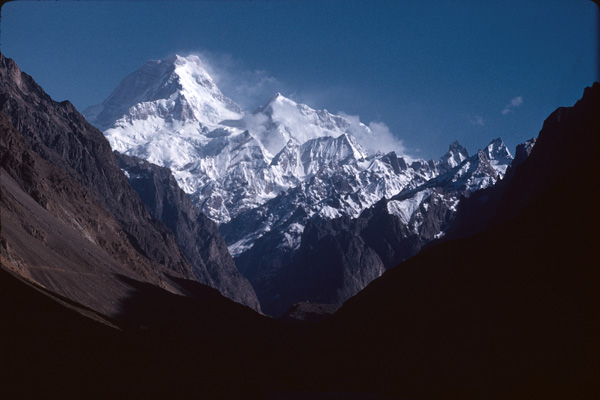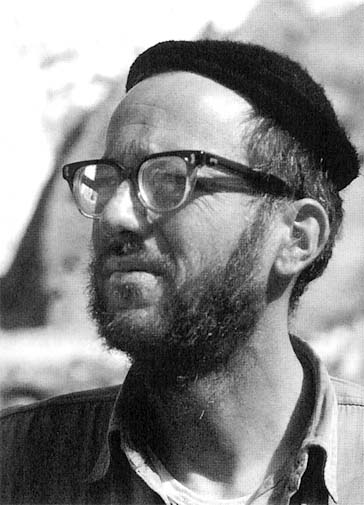|
A Distinguished Scientist, Mountaineer and Friend has Passed
Written by Walter Goad, George Bell Jr.,
Ginny Bell and Carolyn Bell,
with excerpts from the LAM History Project
George Irving
Bell was one of the clubs most well known, distinguished, and
esteemed members. His untimely death was a shock to all.
His club friends fondly remember his wonderful mountaineering and
climbing adventures, and valued his patience with others and his
ability to mentor and lead in a very relaxed manner, while
instilling trust and confidence in all.
In
Brief: George died on May 28th, 2000, from leukemia
complications following routine hernia surgery. George was born on
August 4, 1926 in Evanston, Illinois of George I. Bell (Sr.) and
Hazel Seerley Bell. The family shortly moved to Winnetka, Illinois,
where he graduated from New Trier High School in 1944.
He received a BS in Physics from Harvard
University in 1947 and a PhD in Theoretical Physics from Cornell
University in 1951, where he studied nuclear physics under Hans
Bethe. George was a family man, an avid mountaineer and outdoorsman,
and a successful scientist and manager.
Mountaineering
and Climbing: George's first exposure to
technical climbing came during a summer camp to the Tetons while in
High School. In the 1940s he made first ascents of four peaks in the
area around Mount Waddington in the Coast Range of British Columbia.
During this period, he also climbed in the Tetons, the Wind River
Range, and the Cascades. George became an avid and accomplished
mountaineer and participated in some of the most notable American
expeditions of the 1950s and 1960s. He went on 4 expeditions to the
Peruvian Andes in the 50's, and was a member of teams that made the
first ascent of
Yerupaja in 1950 and of
Salcantay in 1952, two of Peru's highest and most difficult
peaks.
In 1953, George attempted K2 (then unclimbed) with
a well-knit team. They endured a horrific storm for a week at
25,000', and a terrible accident on the way down. He was one of five
climbers who fell during their failed attempt. Their fall was
arrested by Pete Schoening in one of the great feats of
mountaineering. The entire team
could easily have been lost, but miraculously all but one team
member staggered into base camp. This was a pivotal event in the
lives of the seven surviving team members, who became as close as
brothers. George was carried out from base camp and eventually lost
two toes to frostbite. This climb is the subject of the classic
mountaineering book:
K2 The Savage Mountain. Despite this, his enthusiasm for
climbing was undiminished.

View seen by George of K2 from
Hushe Valley in 1960.
Photo courtesy of Tom Hornbein (1960 Masherbrum team mate)
George went on several more Himalayan expeditions,
culminating in the first ascent of
Masherbrum on July 6, 1960. George and Willi Unsoeld reached the
summit of Masherbrum in their first try. At 25,660 feet,
Masherbrum is the 22nd highest peak in the world. According to the
Himalayan index, there have been only three subsequent ascents. The
Los Alamos Mountaineers honor this historical climb and an esteemed
member by featuring
Masherbrum (as seen from the Hushe Valley near Kande) as our club
logo.

Peru, 1954
Photo by Leigh Ortenburger
Selected
References to "George Bell Sr." from the
LAM History Project:
- George and Ginny were early active members of
the Mountaineers, having first meet at a club activity.
- George prepared an article on the
Brazos for the Colorado
Mountain Club's Trail and Timberline publication. The article,
dated March 1972, is still the only published guide to the
Brazos. George provided an excellent description of the cliffs
and marked the routes known at that time, including the names
and dates of the first ascent parties. The article includes
pictures of the Main Cliffs, the Brazos Box area, and the Wedge.
- On October 12, 1969, the Mountaineers climbed
Shiprock on the 30th anniversary of the first ascent. Ernie
Anderson organized this climb and provided a summit register to
leave on top. The climbing party consisted of George Bell, Will
Siri, Eiichi Fukushima, and Mike Hart. Will Siri was a
well-known Everest climber from Seattle, and a leader of the
Sierra Club. David Brower, who had led the first ascent in 1939,
was invited but could not come, so he sent Will Siri instead.
Larry Campbell and Mike Williams took movies of the ascent, but
Larry says that the film was damaged in processing. Eiichi
believes that this was the last climb of Shiprock before the
accident the next spring that led to its closure by the Navajos.
- Bob Cowan remembers that George Bell and John
Marshall were among the Mountaineers Climbing School instructors
in 1967 when he joined.

Masherbrum, 1960
Photo by Nicholas Clinch
Family: George married
Virginia (Ginny) Lotz in 1956. In Ginny he found an
enthusiastic life partner and together they enjoyed many
outdoor adventures. They had two children: Carolyn (b. 1958)
and George Jr. (b. 1960). Family backpacking and climbing
trips were the norm. In their later years, George and Ginny
enjoyed a dozen treks in the Himalayas, and another dozen to
mountain ranges in the rest of the world. Even at age 73, he
remained in remarkable physical shape, hiking 14 miles the
weekend before his death. A brilliant but unassuming man, he
was a great inspiration to his family, his many friends,
colleagues and young aspiring mountaineers.
George is survived by his wife, Ginny; his
elder sister, Dr. Barbara Bell of the Harvard Smithsonian
Center for Astrophysics; his daughter Carolyn Bell
and grandchildren Kaitlin (b. 1987), Austin (b. 1990) and
Derek Prince (b. 1993) of Los Alamos, New Mexico; his son
George Irving Bell, Jr., wife Esther Brady and
grandchildren Allison (b. 1996) and Henry Bell (b. 1999) of
Boulder, Colorado.
Career: George moved to New
Mexico in 1951, where he was a driving force in the
Theoretical Physics Division of the Los Alamos National
Laboratory (LANL) for almost 50 years. In the early part of
his career, he worked on reactor physics and safety,
co-authoring the then
definitive text on the subject and winning a
distinguished award from the American Nuclear Society.
In the 1960s, George was one of small
group of physicists at Los Alamos who began to work
seriously in biology. He focussed on immunology, and in 1970
published a seminal paper formulating a quantitative
immunological model that could be computationally explored.
In 1974, he founded the Theoretical Biology and Biophysics
group, and served as group leader until 1990. Through
George's work and leadership in attracting younger
scientists, this group turned into a leading center for
theoretical immunology and cell biology. He was a founder of
the Center for Human Genome Studies in 1988, and continued
to be actively involved in the Human Genome Project until
his death.
George was known as a superb administator,
and served as Theoretical Physics Division leader from
1980-1989. He authored
three books and hundreds of scientific articles and was
elected a fellow of the American Physical Society and the
American Association for the Advancement of Science (AAAS).
|